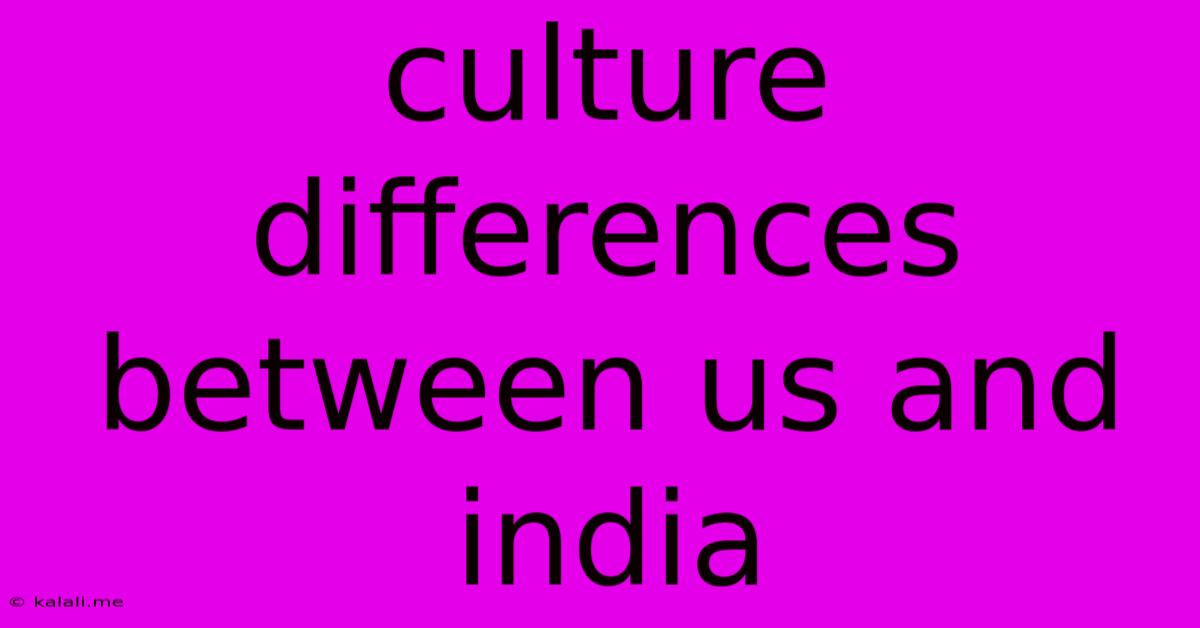Culture Differences Between Us And India
Kalali
Jun 14, 2025 · 3 min read

Table of Contents
Bridging the Gap: Understanding Cultural Differences Between the US and India
The United States and India, two vibrant nations with rich histories, represent vastly different cultural landscapes. While globalization has fostered increased interaction, understanding these nuances is crucial for successful cross-cultural communication and collaboration. This article explores key cultural differences between the US and India, focusing on communication styles, family structures, concepts of time, and professional environments.
Communication Styles: Direct vs. Indirect
One of the most striking differences lies in communication styles. American communication tends to be direct and explicit. Individuals value clarity and straightforwardness, often prioritizing efficiency and getting to the point quickly. In contrast, Indian communication is often more indirect and nuanced. Maintaining harmony and avoiding direct confrontation are highly valued, leading to a more subtle and context-dependent approach. This can sometimes be misinterpreted as ambiguity or a lack of clarity by Americans, while Indians might perceive directness as rude or insensitive. Understanding these variations is crucial for avoiding misunderstandings.
Family Structures and Values:
Family structures significantly differ. The US emphasizes nuclear families, with individuals often prioritizing independence and self-reliance. While family ties remain important, individual autonomy is highly valued. In India, however, extended families are the norm, with strong emphasis on familial obligations and interdependence. Respect for elders is paramount, and family decisions often involve collective input. This difference impacts everything from career choices to personal relationships. Americans might prioritize individual achievement, while Indians might prioritize family harmony and collective success.
Time Perception: Monochronic vs. Polychronic
Time perception also plays a crucial role. American culture is largely monochronic, focusing on schedules, punctuality, and completing tasks one at a time. Meetings have set agendas and timelines. Indian culture, on the other hand, tends to be more polychronic, with a flexible approach to time and a willingness to juggle multiple tasks simultaneously. Deadlines might be viewed as guidelines rather than strict rules, and interruptions are more common. This difference can lead to frustration on both sides. Americans might perceive lateness as disrespectful, while Indians might view adherence to strict schedules as inflexible.
Professional Environments: Hierarchy vs. Collaboration
Professional environments reflect these cultural differences. American workplaces often emphasize collaboration and egalitarianism, fostering open communication and teamwork. While hierarchy exists, it's often less rigid. Indian professional environments, however, tend to be more hierarchical, with a strong emphasis on respect for seniority and authority. Communication flows predominantly from top to bottom, and challenging superiors directly might be considered disrespectful. This difference in workplace dynamics requires awareness and adaptation from both sides.
Beyond the Surface:
These are just some key areas where US and Indian cultures differ. Other important factors include religious practices, social etiquette, and attitudes towards personal space. It's crucial to remember that these are broad generalizations, and individual experiences will vary. However, understanding these fundamental differences promotes better communication, stronger relationships, and more successful collaborations between individuals and organizations from both nations. Cultivating cultural sensitivity and a willingness to learn and adapt are essential for navigating this complex intercultural landscape. By embracing these differences and fostering mutual understanding, we can build bridges and achieve mutual success in an increasingly interconnected world.
Latest Posts
Latest Posts
-
Who Wrote The Guru Granth Sahib
Jun 15, 2025
-
The Demand Curve Faced By A Perfectly Competitive Firm Is
Jun 15, 2025
-
Which Word Is An Antonym Of Trivial
Jun 15, 2025
-
Chemoreceptors Are Located In All Of The Following Except
Jun 15, 2025
-
Which Of The Following Are Characteristics Of A Normal Distribution
Jun 15, 2025
Related Post
Thank you for visiting our website which covers about Culture Differences Between Us And India . We hope the information provided has been useful to you. Feel free to contact us if you have any questions or need further assistance. See you next time and don't miss to bookmark.